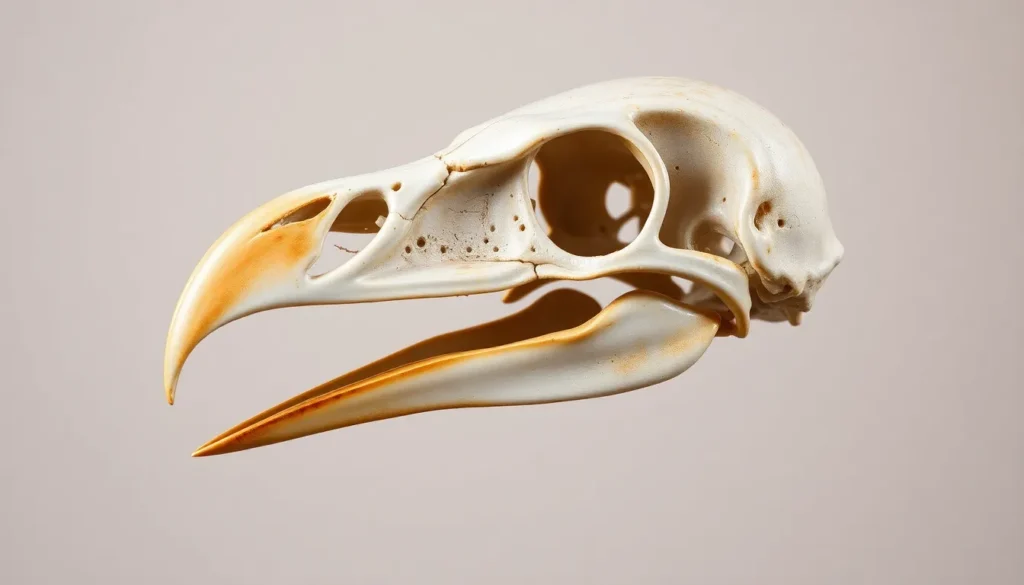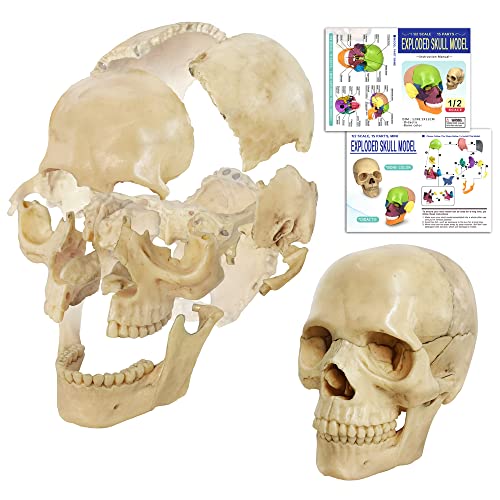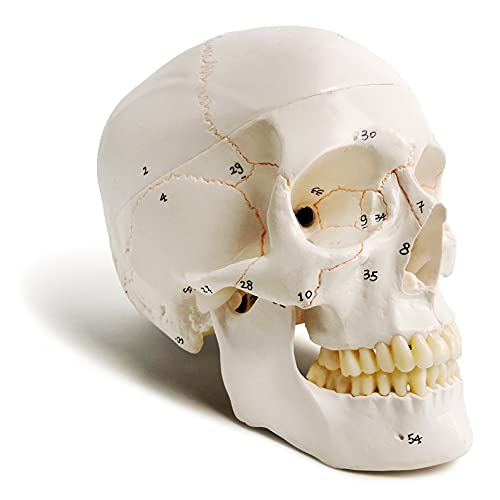Bird skulls represent some of nature’s most remarkable engineering feats. We’ve all marveled at birds soaring through the sky, but few of us consider the incredible cranial adaptations that make flight possible. These lightweight yet sturdy structures showcase millions of years of evolutionary refinement.
From the tiniest hummingbird to the largest eagle, bird skulls share fascinating characteristics that set them apart from all other vertebrates. We’re talking about bones so light they’re almost hollow, yet strong enough to withstand the incredible forces of flight and feeding. The fusion patterns, air spaces, and specialized features tell an amazing story of survival and adaptation.
Whether you’re a biology student, bird enthusiast, or simply curious about nature’s design principles, understanding bird skull anatomy opens up a whole new appreciation for these incredible creatures. We’ll explore the unique features that make bird skulls so perfectly suited for their aerial lifestyle and examine how different species have adapted their cranial structures for specialized feeding and survival strategies.
Understanding the Basic Anatomy of a Bird Skull
The intricate design of bird skulls showcases nature’s perfect balance between strength and weight efficiency. We’ll explore the fundamental components that make these structures so remarkably adapted for flight.
Cranium Structure and Function
Pneumatization creates the lightweight foundation that distinguishes bird skulls from other vertebrates. Air-filled cavities within the cranial bones reduce overall weight by up to 20% while maintaining structural integrity through strategic bone placement.
Fusion patterns eliminate unnecessary joints between cranial bones, creating a solid protective case for the brain. We observe complete fusion in adult birds, unlike mammals that retain sutures throughout life.
Brain cavity proportions vary significantly among species based on cognitive demands. Corvids like ravens and crows possess enlarged craniums that house complex neural networks, while smaller songbirds maintain more compact brain cases.
Temporal fenestrae provide attachment points for powerful jaw muscles essential for feeding behaviors. These openings behind each eye socket allow muscle fibers to connect directly to the skull, generating bite force appropriate for each species’ diet.
Beak Formation and Composition
Premaxilla and maxilla bones form the upper mandible through precise evolutionary shaping that reflects feeding specialization. These fused elements create the foundational structure that supports the keratinous covering we recognize as the beak.
Mandibular bones construct the lower jaw with flexible connections allowing for varied mouth opening angles. The quadrate bone acts as a hinge mechanism, enabling birds to achieve impressive gape widths when consuming large prey items.
Keratin sheaths cover the underlying bone with thickness varying from paper-thin in hummingbirds to incredibly robust in macaws and toucans. This protein layer continuously grows throughout a bird’s lifetime, compensating for natural wear from daily activities.
Nostril positioning reflects lifestyle adaptations with variations ranging from tube-like structures in seabirds to protected slits in woodpeckers. We find that ground-foraging species often possess elevated nostrils to prevent debris infiltration during feeding.
Eye Socket Adaptations
Orbital size correlates directly with visual acuity requirements, with nocturnal hunters like owls possessing proportionally massive eye sockets. These enlarged cavities accommodate eyes that can comprise up to 5% of total body weight in some raptor species.
Sclerotic rings provide structural support for enormous eyes through a series of small overlapping bones that maintain eye shape under flight pressure changes. This unique adaptation prevents optical distortion during rapid altitude shifts.
Supraorbital processes create protective overhangs that shield eyes from debris and intense sunlight exposure. We observe pronounced development of these bone ridges in desert species and high-altitude fliers that encounter harsh environmental conditions.
Interorbital septum thickness varies based on binocular vision requirements, with predatory birds maintaining thin barriers for maximum forward sight overlap. Prey species typically possess thicker separations that support wider peripheral vision ranges for predator detection.
Examining the Lightweight Design Features of Bird Skulls
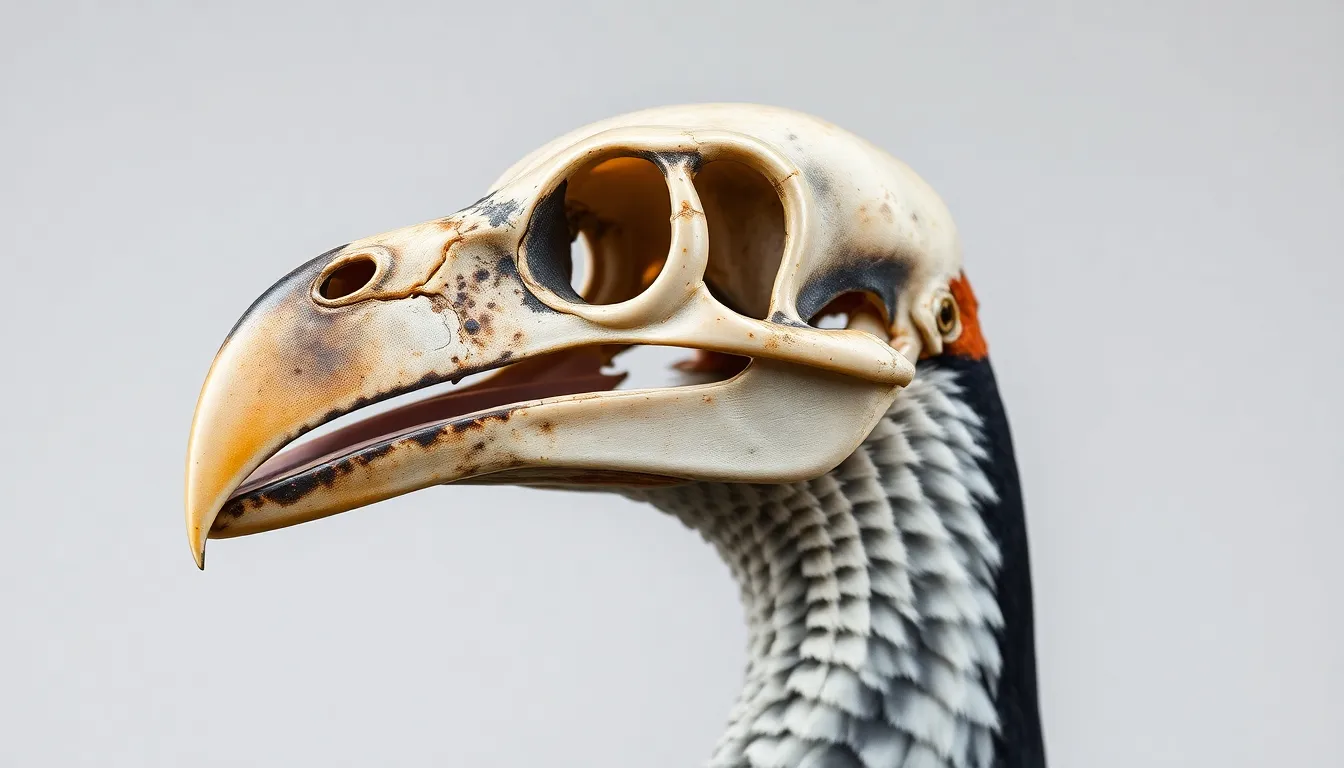
Building upon the structural foundations we’ve explored, bird skulls showcase extraordinary weight-saving innovations that make flight possible. These specialized adaptations represent millions of years of evolutionary refinement.
Pneumatic Bone Structure
Pneumatization creates hollow spaces within bird skull bones that dramatically reduce overall weight while maintaining structural integrity. We observe this remarkable adaptation primarily in the frontal bones, where air-filled cavities can reduce bone mass by up to 40% compared to solid bone structures.
Frontal bone pneumatization varies significantly among species based on their flight requirements and ecological niches. Large soaring birds like albatrosses exhibit extensive pneumatic chambers throughout their skull bones, while smaller songbirds show more selective pneumatization patterns.
Temporal bone modifications include hollow spaces that connect directly to the respiratory system, creating an integrated network of air passages. These modifications allow bones to maintain their protective function while weighing considerably less than their mammalian counterparts.
Occipital bone adaptations feature specialized chambers that house extensions of the air sac system, contributing to both weight reduction and thermoregulation. The degree of pneumatization in this region often correlates with the bird’s flight capabilities and metabolic demands.
Air Sac Integration
Air sacs extend into skull bones through specialized openings called pneumatic foramina, creating a continuous respiratory network. We find these connections most prominently in the frontal, temporal, and occipital regions where they form part of the bird’s highly efficient breathing system.
Cervical air sac extensions penetrate deep into the skull base, connecting with the middle ear spaces and creating additional weight savings. This integration allows birds to maintain constant airflow through their respiratory system even during the demanding physical activity of flight.
Clavicular air sac connections reach into the skull through the temporal regions, forming part of the anterior air sac system. These connections help regulate pressure changes during altitude variations and contribute to the overall respiratory efficiency that flight demands.
Diverticula formation creates small branch-like extensions of air sacs into various skull bones, maximizing the pneumatic effect while maintaining bone strength. The complexity of these formations often reflects the species’ flight patterns and altitude preferences.
Weight Reduction Mechanisms
Bone density modifications allow bird skulls to achieve remarkable strength-to-weight ratios through strategic material distribution. We observe cortical bone thickness variations that place dense material only where maximum strength is needed, typically around stress concentration points.
Trabecular bone optimization creates internal support structures that use minimal material while providing maximum structural support. These honeycomb-like arrangements distribute loads efficiently throughout the skull, preventing fractures during high-impact activities like diving or collision with obstacles.
Calcium deposition patterns show strategic placement of dense mineral content in high-stress areas while leaving non-critical regions with reduced mineralization. This selective strengthening approach allows birds to maintain skull integrity without unnecessary weight penalties.
Surface area maximization through internal chambers and passages increases the bone’s structural efficiency without adding mass. The resulting architecture resembles modern aerospace engineering principles, where every gram of material serves a exact structural purpose while contributing to overall weight reduction goals.
Identifying Different Bird Skull Types Across Species
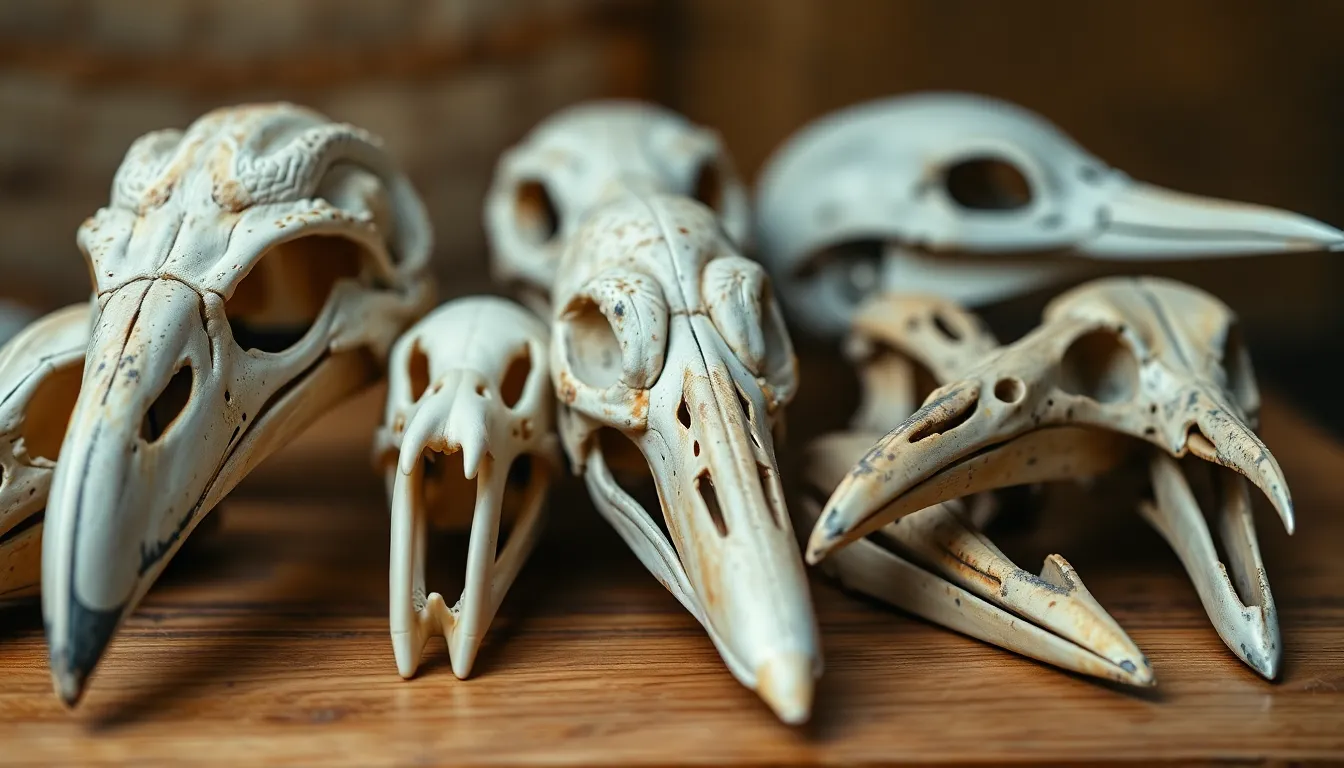
Examining bird skulls across species reveals distinct adaptations that reflect each group’s feeding strategies and ecological demands. These specialized skull features help us understand how different bird families evolved to fill unique environmental niches.
Raptor Skull Characteristics
Raptor skulls showcase powerful predatory adaptations with hooked beaks formed by enlarged premaxilla bones that curve downward sharply. We observe massive temporal fenestrae in eagles, hawks, and owls that accommodate powerful jaw muscles for delivering crushing bites to prey.
Forward-facing eye sockets dominate raptor skull architecture with large orbital cavities positioned close together for enhanced depth perception. Species like great horned owls possess asymmetrical ear openings that create precise sound triangulation capabilities for nocturnal hunting.
Reinforced skull structures support high-impact hunting behaviors through thickened frontal bones and robust zygomatic arches. Peregrine falcons display especially dense bone construction around the nostrils to withstand extreme air pressure during high-speed dives exceeding 200 mph.
Songbird Skull Features
Songbird skulls exhibit lightweight construction with extensive pneumatization patterns that reduce weight by up to 40% compared to similar-sized mammals. We find delicate bone structures in species like cardinals and finches that prioritize agility over impact resistance.
Diverse beak shapes reflect specialized feeding adaptations ranging from the needle-sharp bills of hummingbirds to the seed-cracking capabilities of cardinal skulls. Crossbills demonstrate extreme specialization with asymmetrical mandibles that perfectly align for extracting conifer seeds.
Enhanced brain cavity proportions support complex vocalizations through enlarged areas housing the syrinx control centers. Mockingbirds and thrushes show particularly developed temporal regions associated with song learning and vocal mimicry abilities.
Waterfowl Skull Adaptations
Waterfowl skulls feature broad, flattened profiles optimized for surface feeding and underwater foraging through specialized bill structures. We observe extensive lamellae (filtering plates) along the edges of duck and goose mandibles for straining food particles from water.
Elevated nostril positioning prevents water intake during diving and surface feeding activities in species like mallards and teals. Merganser skulls display serrated bill edges resembling teeth for gripping slippery fish prey.
Reinforced skull architecture supports diving pressures in species like loons and grebes through denser bone construction and modified air sac systems. These adaptations allow birds to withstand water pressure changes during deep underwater pursuits reaching depths of 200 feet in common loons.
Analyzing How Bird Skull Shape Relates to Diet
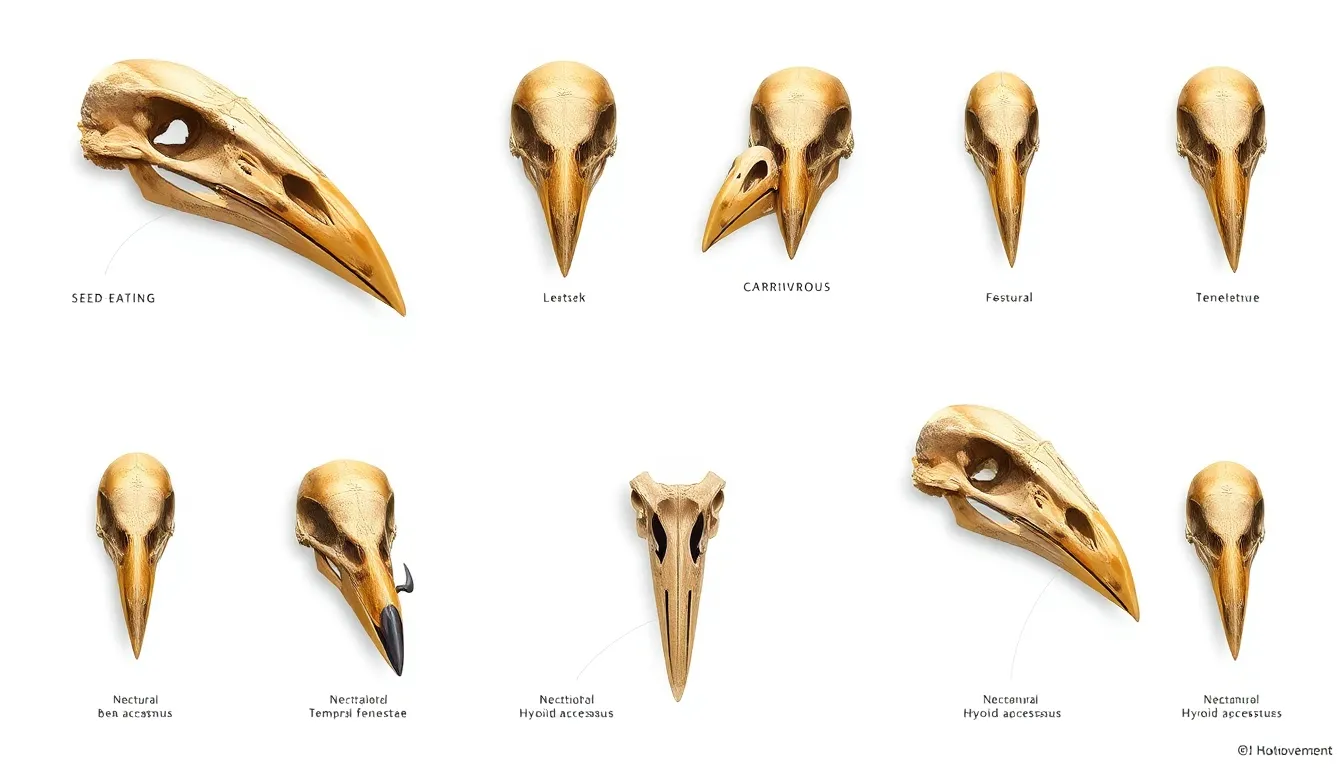
Bird skull anatomy reveals fascinating connections between cranial structure and feeding behavior. We can observe distinct evolutionary adaptations that directly correlate with dietary requirements across different species.
Seed-Eating Bird Skull Modifications
Seed-eating birds develop robust skull structures designed for powerful crushing capabilities. We find that species like finches and cardinals possess enlarged temporal fossae that accommodate massive jaw muscles, allowing them to generate impressive bite forces of up to 70 pounds per square inch. Their mandibles feature reinforced bone density particularly around the coronoid process where primary muscle attachments occur.
Conical beak formations emerge from specialized premaxilla and maxilla configurations. These structures create optimal leverage for cracking seeds, with the upper mandible often displaying pronounced ridges that prevent seeds from slipping during processing. We observe that grosbeak skulls show extreme adaptations with enlarged quadrate bones that provide additional jaw muscle attachment points.
Palatine bones undergo important modifications to support seed processing mechanisms. Many granivorous species develop specialized ridges along their palatal surfaces that help position seeds for optimal cracking angles. The hyoid apparatus in these birds often features shortened elements that create more space for enlarged tongue muscles used in seed manipulation.
Carnivorous Bird Skull Specializations
Carnivorous birds exhibit dramatically enlarged temporal fenestrae to house powerful jaw muscles. We measure these openings as comprising up to 40% of total skull surface area in species like hawks and eagles, compared to just 15% in seed-eating birds. Their zygomatic arches form pronounced ridges that anchor the temporalis muscles responsible for delivering crushing bite forces.
Hooked beak structures emerge from extensively modified premaxilla bones. These adaptations create razor-sharp cutting edges perfect for tearing flesh, with the maxilla featuring pronounced curves that maximize mechanical advantage. We find that owl skulls show unique asymmetrical adaptations where one temporal fossa may be larger than the other to accommodate directional hearing requirements.
Reinforced skull architecture supports the extreme forces generated during prey capture. The frontal bones in raptors often display thickened sections around the supraorbital processes, providing anchor points for powerful neck muscles. Their occipital regions show expanded attachment areas for the complex muscle systems that control precise head movements during hunting strikes.
Nectar-Feeding Bird Skull Adaptations
Nectar-feeding birds develop extraordinarily lightweight skull constructions optimized for hovering flight. We document that hummingbird skulls weigh just 0.1 grams on average while maintaining structural integrity through extensive pneumatization patterns. Their temporal regions show reduced muscle attachment sites since powerful jaw crushing isn’t required for their liquid diet.
Elongated beak structures result from extreme premaxilla and mandible extensions. These modifications create specialized feeding tubes that can reach deep into flower corollas, with some species achieving beak lengths exceeding their total body length. The nasal septum in these birds often becomes completely fused to provide additional structural support for their extended feeding apparatus.
Hyoid bone systems undergo remarkable adaptations for nectar extraction mechanisms. We observe that hummingbird hyoid apparatus can extend up to 80% of their total body length, wrapping around the skull and anchoring behind the eyes. Their skull base modifications include enlarged foramina that accommodate the extended hyoid elements, creating space for the complex tongue projection systems essential for nectar feeding.
Discovering the Evolution of Bird Skull Structure
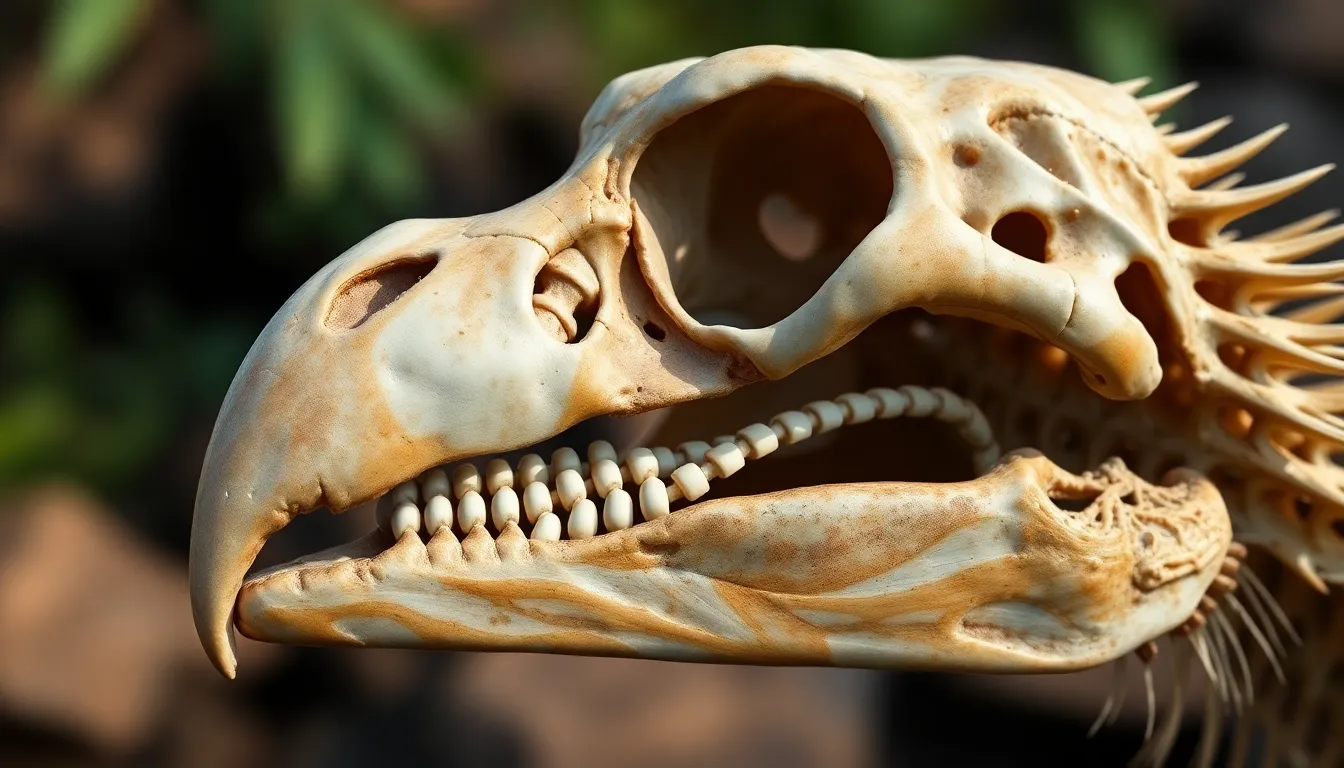
Understanding how bird skulls evolved reveals the remarkable journey from ancient reptilian ancestors to today’s flight-optimized designs. We can trace this transformation through millions of years of fossil evidence and developmental changes.
Ancestral Reptilian Features
Ancient bird ancestors retained several key reptilian skull characteristics that we still observe in modern bird development. Temporal fenestrae provided the foundational framework for jaw muscle attachment, though early forms were much larger and more pronounced than today’s streamlined versions. Diapsid skull construction formed the basic template, featuring two temporal openings behind each eye socket that allowed for powerful jaw muscle development.
Early theropod dinosaurs displayed heavy, solid bone construction throughout their skulls, contrasting sharply with the lightweight pneumatic structures we see in contemporary birds. Teeth occupied both upper and lower jaw regions in ancestral forms, requiring robust mandibular structures to support biting forces. Separate cranial bones remained unfused in primitive species, creating flexibility but sacrificing the structural integrity that modern flight demands.
Brain cavity proportions were significantly smaller in early bird ancestors, reflecting less complex cognitive processing compared to today’s intelligent species. Nasal passages remained simple and straight, lacking the sophisticated turbinate structures that enhance respiratory efficiency in current birds.
Evolutionary Advantages of Modern Design
Modern bird skull evolution produced extraordinary adaptations that revolutionized flight capabilities and feeding efficiency. Weight reduction became the primary driving force, leading to pneumatization throughout cranial bones and creating the hollow structures we observe today. Fusion patterns eliminated unnecessary joints, transforming multiple separate elements into solid, integrated units that provide superior protection while minimizing mass.
Specialized beak development replaced heavy tooth-bearing jaws, allowing for precise feeding adaptations without the weight penalty of dental structures. Enhanced brain capacity accommodated complex flight navigation, with enlarged cerebellums supporting sophisticated motor control and spatial awareness. Improved respiratory integration connected skull air spaces directly to the pulmonary system, creating continuous airflow that supports high-energy flight activities.
Enlarged eye sockets evolved to house superior visual systems, with many species developing orbital sizes that accommodate eyes weighing more than their entire brain. Streamlined profiles reduced air resistance during flight, while maintaining structural strength through optimized bone thickness and internal architecture.
Fossil Evidence and Developmental Changes
Fossil records reveal the gradual transformation from reptilian to avian skull architecture through several key transitional species. Archaeopteryx demonstrated the first major shift toward modern design, featuring reduced temporal fenestrae and initial pneumatization in certain cranial bones. Later transitional forms like Hesperornis showed progressive tooth loss and enhanced brain case development.
Developmental studies illuminate how embryonic bird skulls recapitulate evolutionary history, with early stages displaying separate bone elements that gradually fuse as development progresses. Growth patterns reveal the precise timing of pneumatization, typically beginning in the frontal bones before spreading to other cranial elements. Comparative embryology demonstrates how different species modify basic developmental programs to achieve specialized adult forms.
Recent discoveries of well-preserved Cretaceous bird fossils provide detailed insights into intermediate skull forms, showing gradual transitions in temporal fenestra size and bone fusion patterns. Microscopic analysis of fossil bone structure reveals the evolution of trabecular architecture, documenting how internal bone organization became increasingly optimized for weight reduction while maintaining strength.
Learning About Bird Skull Collection and Preservation
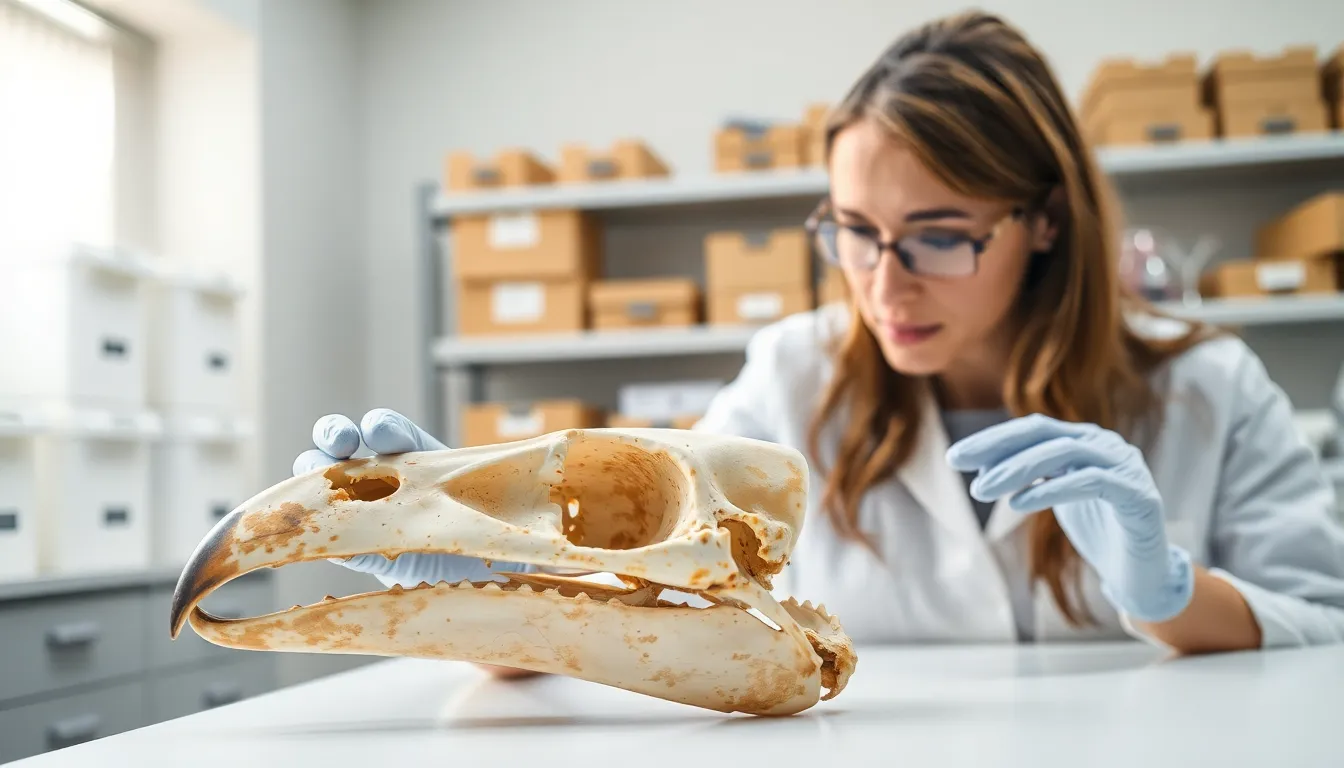
Understanding proper collection and preservation techniques helps us maintain bird skull specimens for educational and research purposes. We must approach this field with respect for wildlife regulations and scientific methodology.
Ethical Collection Practices
Legal permits serve as the foundation for any bird skull collection try. We need federal collecting permits from the U.S. Fish and Wildlife Service before handling any migratory bird remains. State licenses often supplement federal requirements, creating a comprehensive legal framework for specimen acquisition.
Natural mortality sources provide the most ethical specimens for our collections. We can locate bird skulls at wildlife rehabilitation centers, veterinary clinics, and natural history museums that receive deceased birds. Window strike victims, vehicle casualties, and birds that die of natural causes offer legitimate collection opportunities without harming living populations.
Documentation standards ensure our collections maintain scientific value. We must record collection dates, locations with GPS coordinates, species identification, and cause of death when known. Field notebooks capture essential metadata that transforms random specimens into valuable research materials.
Partnership networks expand our access to quality specimens ethically. We collaborate with bird banders, wildlife biologists, and research institutions that encounter deceased birds during their work. These relationships provide regular specimen sources while supporting conservation efforts.
Cleaning and Preparation Techniques
Dermestid beetle colonies offer the most effective skull cleaning method for serious collectors. We maintain these specialized insects in controlled environments where they consume soft tissue while leaving delicate bone structures intact. The process takes 2 to 4 weeks depending on skull size and requires temperature regulation between 70 and 80 degrees Fahrenheit.
Chemical preparation techniques work well for single specimens or occasional cleaning needs. We use biological detergent answers to break down remaining tissue after initial flesh removal. Warm water soaks lasting 24 to 48 hours soften stubborn connective tissues without damaging fragile bone elements.
Enzyme treatments accelerate the cleaning process while preserving structural integrity. We apply commercial enzyme powders mixed with warm water to dissolve proteins and fats efficiently. These biological cleaners work particularly well on waterfowl skulls that contain substantial fat deposits within pneumatic bones.
Final preparation steps ensure long term specimen stability. We remove all cartilage remnants using fine forceps and dental picks, then degrease skulls using acetone or denatured alcohol. Multiple solvent baths eliminate oils that could attract pests or cause deterioration over time.
Long-term Storage Methods
Climate controlled environments protect our bird skull collections from environmental damage. We maintain storage areas at 65 to 70 degrees Fahrenheit with relative humidity between 45 and 55 percent. These conditions prevent bone expansion, contraction, and mold growth that compromise specimen integrity.
Archival quality storage materials ensure specimens remain accessible for decades. We use acid free boxes, cotton batting, and museum grade foam supports that won’t deteriorate or release harmful chemicals. Each skull receives individual protection within larger storage containers to prevent contact damage.
Pest management protocols safeguard our collections from destructive insects. We carry out integrated pest management using sticky traps, regular inspections, and controlled environments that discourage infestations. Dermestid beetles, carpet beetles, and other pests can destroy unprotected specimens within months.
Digital cataloging systems track our specimens and enhance research capabilities. We photograph each skull from multiple angles, create detailed measurement records, and maintain database entries with collection information. These digital archives preserve specimen data even if physical materials face unexpected damage or loss.
Exploring Bird Skull Research and Scientific Applications
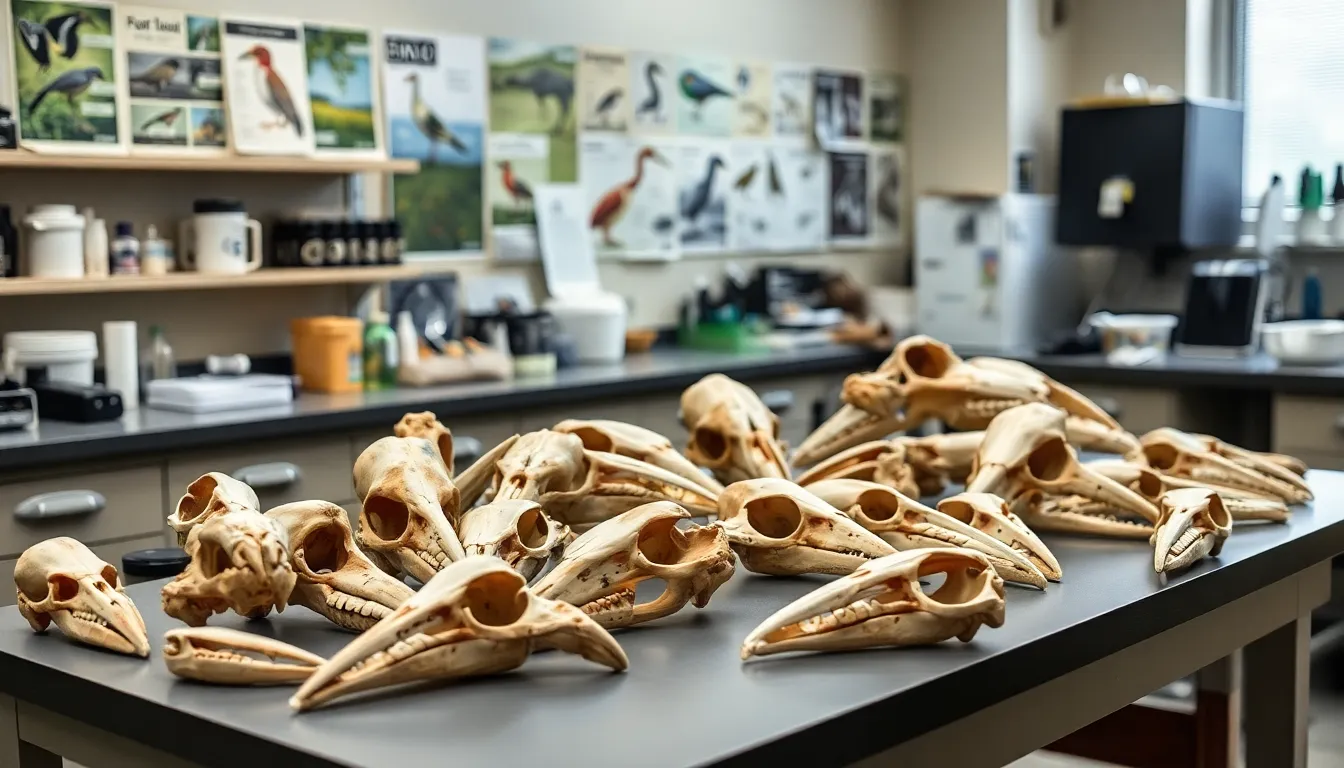
Scientists worldwide use bird skull specimens to advance our understanding of avian biology and ecology. These research applications extend far beyond basic anatomy studies.
Taxonomic Classification Uses
Taxonomic identification relies heavily on skull morphology measurements and distinctive cranial features. We examine exact bone proportions, beak curvature angles, and temporal fenestrae dimensions to distinguish between closely related species. Morphometric analysis software processes hundreds of skull measurements simultaneously, creating statistical models that identify species with remarkable accuracy.
Phylogenetic relationships emerge through comparative skull studies across different bird families. Researchers analyze cranial fusion patterns, pneumatization levels, and orbital configurations to trace evolutionary lineages. Museum collections house thousands of skull specimens from various geographic regions, enabling scientists to document subspecies variations and population differences.
DNA extraction from skull bone samples provides genetic data that complements morphological findings. Modern techniques extract viable genetic material from specimens collected decades ago, revolutionizing our understanding of bird evolution. Isotope analysis of skull bone reveals migration patterns and dietary habits across different time periods.
Behavioral Studies Through Skull Analysis
Behavioral patterns correlate directly with skull structure measurements and specialized cranial adaptations. We measure bite force capabilities by analyzing jaw muscle attachment sites and temporal fenestrae dimensions. Brain endocasts created from skull cavities reveal cognitive abilities and sensory processing capacities across different species.
Feeding behavior studies use skull morphology to predict dietary preferences and foraging strategies. Scientists correlate beak dimensions with prey size preferences, while analyzing orbital socket positioning to understand visual hunting techniques. Nocturnal species exhibit enlarged orbital cavities and specialized ear opening configurations that enhance night hunting capabilities.
Social behavior patterns connect to brain cavity proportions and exact skull regions associated with communication. Songbird species display enlarged areas corresponding to vocal learning centers, while colonial nesters show cranial features linked to social processing abilities. Migratory species demonstrate skull adaptations that support enhanced spatial navigation and magnetic field detection.
Conservation Efforts and Data Collection
Conservation programs use skull measurements to monitor population health and genetic diversity within endangered species. We track skull size variations over time to identify environmental stressors and habitat degradation impacts. Comparative studies between historical and contemporary specimens reveal evolutionary responses to climate change and human activities.
Breeding program success relies on skull morphology data to maintain genetic diversity and prevent inbreeding depression. Captive populations require careful monitoring of cranial development patterns to ensure healthy offspring production. Reintroduction efforts benefit from skull analysis that confirms genetic authenticity and population origin.
Field research stations collect skull specimens from natural mortality events to build comprehensive databases. Citizen science programs train volunteers to document skull findings, expanding data collection across remote geographic areas. International collaboration networks share skull measurement databases, enabling global conservation efforts and species monitoring programs.
| Research Application | Key Measurements | Sample Size Requirements |
|---|---|---|
| Species identification | 15-20 morphometric points | 50+ specimens per species |
| Population genetics | DNA extraction success rate | 25-30 specimens per population |
| Behavioral correlation | Brain endocast volume | 30+ specimens per behavior type |
| Conservation monitoring | Annual skull size variation | 100+ specimens per decade |
Conclusion
Bird skulls represent one of nature’s most impressive engineering achievements combining lightweight design with remarkable strength. We’ve explored how these intricate structures support flight while enabling diverse feeding strategies across species.
Understanding bird skull anatomy deepens our appreciation for avian evolution and adaptation. From the pneumatic bones that reduce weight to the specialized beak shapes that define feeding behaviors these features showcase millions of years of evolutionary refinement.
Whether you’re studying avian biology conducting research or simply observing birds in your backyard this knowledge enhances our connection to these remarkable creatures. Bird skulls continue to reveal new insights about evolution behavior and the incredible diversity of life on our planet.
Frequently Asked Questions
What makes bird skulls different from other vertebrates?
Bird skulls are uniquely engineered for flight with lightweight, hollow pneumatic bones that maintain strength while reducing weight. They feature extensive bone fusion creating a solid protective case, temporal fenestrae for jaw muscle attachment, and air spaces connected to the respiratory system. These adaptations represent millions of years of evolution optimizing skull structure for aerial life.
How do bird skulls achieve their lightweight structure?
Bird skulls use pneumatization – hollow air spaces within bones connected to air sacs – to dramatically reduce weight while maintaining structural integrity. They also feature optimized bone density, trabecular bone modifications, and strategic fusion patterns. These weight-saving innovations create remarkable strength-to-weight ratios essential for flight capabilities.
How does skull shape relate to a bird’s diet?
Bird skull morphology directly reflects feeding strategies. Seed-eating birds have robust skulls for crushing, carnivorous birds feature enlarged temporal fenestrae for powerful jaw muscles, and nectar-feeders have extremely lightweight constructions optimized for hovering. Beak shape, jaw muscle attachments, and overall skull structure all adapt to specific dietary needs.
What are the main differences between raptor and songbird skulls?
Raptor skulls feature powerful predatory adaptations including hooked beaks, massive temporal fenestrae for strong jaw muscles, and robust construction for capturing prey. Songbird skulls exhibit lightweight construction with specialized beak shapes for diverse feeding methods, smaller temporal fenestrae, and optimized weight distribution for agile flight and perching behaviors.
How do bird skulls support their vision capabilities?
Bird skulls have large orbital cavities proportional to their visual needs, with nocturnal hunters having particularly enlarged eye sockets. Sclerotic rings provide structural support for the eyes, while supraorbital processes offer protection. The interorbital septum thickness varies based on vision requirements, with predatory species often having enhanced visual adaptations.
What role does pneumatization play in bird skull function?
Pneumatization creates hollow spaces within skull bones that connect to the respiratory system, forming a continuous network that enhances breathing efficiency during flight. This adaptation significantly reduces skull weight while maintaining structural integrity, with variations among species reflecting their specific flight requirements and ecological adaptations.
How can bird skulls be ethically collected and preserved?
Ethical collection requires legal permits and sourcing from natural mortality events rather than active hunting. Specimens should be thoroughly documented for scientific value, cleaned using dermestid beetles or chemical treatments, and stored in climate-controlled environments with archival materials. Digital cataloging systems help track specimens and preserve research data.
What scientific applications do bird skull studies have?
Bird skull research supports taxonomic classification, phylogenetic studies tracing evolutionary lineages, and behavioral analysis correlating structure with feeding habits. Advanced morphometric analysis and DNA extraction techniques enhance species identification. Conservation efforts use skull measurements to monitor population health, genetic diversity, and environmental impacts on bird communities.

